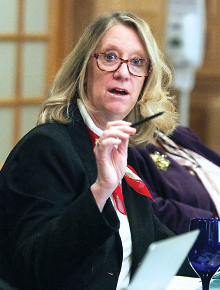Health Care, Including Mental Health Care, Is Human Right, Trustees Declare
Abstract
Trustees approve a new position on health care rights and focus on issues related to physician burnout as well as innovations in digital mental health and service delivery.
Health care, inclusive of mental health care, is a human right.

APA President Anita Everett, M.D., who has made innovation a priority focus of her presidential year, hopes members can use the model of learning from other systems to incorporate innovations in the delivery of psychiatric care.
That’s what APA’s Board of Trustees declared in a position statement approved at last month’s meeting in Arlington, Va. The position statement, sponsored by the Washington Psychiatric Society and approved as an action paper by the Assembly last May, notes that the health of “individuals and populations is an essential asset for robust economies and democracies” and is “essential to a nation’s security and prosperity.”
In an interview after the meeting, the lead author of the paper, Eliot Sorel, M.D., noted that the AMA’s Principles of Medical Ethics state that physicians have a responsibility to seek changes in the health care system that benefit patients and to work for the betterment of the community and public health.
“Health is an asset not only to individuals and families but also to the nation,” said. “A healthy workforce is essential to productivity. Depression is one of the most prevalent conditions in the United States, and untreated depression interferes with productivity and has a direct economic impact. It’s remarkable that citizens in the richest country in the world don’t have access to health care as a fundamental human right.”
A work group of the Council on Psychiatry and Law, led by past APA President Renȳe Binder, M.D., analyzed the position statement for several potential concerns—especially whether the statement would legally bind members to treating every patient who seeks care.
In an interview after the meeting, Binder said the work group believed that the statement speaks to the rights of patients, not to the obligations of providers, and that it is addressed to policymakers and the public as a statement about how health care should be regarded within a health system.
Echoing the report of the work group, Binder noted that only in correctional facilities within the United State is health care recognized as a right. “Health care is a human right and should be identified as such,” she said. “This is the right position for APA to take. We should help move the country toward seeing health care and mental health care as basic human rights.”
Sorel said prevention, early intervention, and integration of primary care and mental health care are essential.

Chandan Khandai, M.D., M.S., voices support for an action paper declaring health care, including mental health, be considered a human right. He is a 2017-2018 APA/APAF Leadership Fellow.
“Noncommunicable disorders do not occur in silos,” he said. “Whatever system we develop requires integration of mental health and primary care. Moreover, we intervene too late. A system that understands health care as a human right needs to have a strong component of health protection, promotion, and illness prevention and a model of total health that integrates primary care, mental health, and public health.”
In other business, the APA Board also approved a position statement emphasizing the potential negative impact of increasing focus by the Centers for Medicare and Medicaid Services (CMS) on ligature risks on psychiatric units.
APA CEO and Medical Director Saul Levin, M.D., M.P.A., said APA has communicated with CMS about the policy and been asked to work with CMS as it develops the final rules. “While APA supports the goal of making institutions as risk-free as possible, it is unrealistic to think that all risks can be anticipated and eliminated,” he said.
Trustees also heard a special presentation from Zeev Neuwirth, M.D., senior medical director of population health at the Carolinas HealthCare System Medical Group, titled “What Medicine Can Learn From Marketing: A Consumerist Approach to Rebranding, Redesigning, and Reorganizing Healthcare” (see story on facing page).
Additionally, trustees heard reports from Richard Summers, M.D., chair of the Work Group on Physician Wellness and Burnout, and from John Torous, M.D., co-chair of the Work Group on Access and Innovation. The work groups were appointed by APA President Anita Everett, M.D., as part of her presidential year priorities.
The Work Group on Physician Wellness and Burnout has developed a variety of tools for members, available on the APA website. These include a self-assessment tool that provides anonymous data to the work group while giving members the opportunity to gauge their level of stress. The self-assessment tool asks users a series of questions about demographics (age, practice type, year of graduation from medical school, among other variables) and about their satisfaction with their professional activities.
Summers told Trustees that to date some 470 members have used the tool. It will be available on the APA website for at least the next year. A preliminary data analysis in the spring will assist APA in creating a strategic plan for addressing burnout among members, he said.
Torous told the Board that within the space of just a few months, there have been high-profile developments in the area of digital technology around mental health—including the announcement by Facebook that it would be rolling out artificial intelligence software to detect possible suicidal intention in posts. Additionally, he noted that the Food and Drug Administration had recently approved Abilify MyCite, an oral form of Abilify that includes a digital sensor for monitoring ingestion of the pill (Psychiatric News, December 1, 2017).
Meanwhile the proliferation of smartphone applications continues. The work group has developed an “app evaluator” that can be accessed on the APA website. The evaluator allows users to enter information about an app on four crucial areas: safety/privacy, evidence of effectiveness, ease of use, and interoperability (the ability of the app to share the data it collects with an electronic health record or with other apps and data gathering tools). The website also offers an example of how the evaluator is used that demonstrates more specifically what kind of information is assessed and how it can be helpful to members in assessing the value of an app.
“These technologies have the potential to be transformative, but a lot of questions remain,” Torous said. “We still have a lack of sufficient research [on many or most of the smartphone apps]. There are many groups and different players in the digital mental health arena, and it remains to be seen what kind of business models will evolve around these technologies.
“The most important point for psychiatry and for APA is that we continue to advocate for the preservation of our professional values in the development and marketing of these new technologies,” Torous said.
He said the work group on access and innovation was focusing on three broad areas:
How can APA be a leader in the development of standards around digital mental health technology? “Ideally, APA should become the hub of data for digital mental health,” Torous said.
How can psychiatry and APA ensure that technological innovations support psychiatric care and do not trespass on professional and ethical values?
How can APA prepare members for technological changes in the future?
Trustees also approved the following four new position statements in addition to the new policy asserting health care, including mental health care, as a human right:
Statement on Domestic Violence Against Women expresses APA’s recognition of “the major psychological sequelae of domestic violence against women and as such strongly advocates prevention and better detection of domestic violence against women; improved treatment of victims, offenders, and children; and continued research into the causes, consequences, and prevention of such violence.”
Statement on Prevention of Violence expresses APA’s support for “primary, secondary, and tertiary approaches to the prevention of violence.” It also states that APA will “advocate for the education of trainees and practicing psychiatrists about violence prevention.”
Statement on Police Interactions With Persons With Mental Illness asserts that APA “strongly supports efforts to enhance the ability of law enforcement to manage crises involving emotionally disturbed persons and persons with serious mental illness, developmental or intellectual disabilities, neurocognitive disorders, or substance use disorders.” The statement adds, “Such efforts should include implementation of a curriculum for law enforcement officers that includes basic information about mental disorders; creation of partnerships between local behavioral health and law enforcement systems to develop policies regarding their respective roles and responsibilities in managing mental health crises; and the prioritization of behavioral health system partnerships with law enforcement that maximize clinical crisis response capacity, including providing settings that facilitate police diversion from arrest and proper clinical assessment and treatment of the person in crisis.” ■



